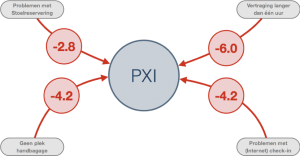
Transavia
Transavia SmartData
Problem Statement
Transavia works with the passenger Experience Index (PXI); Key performance indicator that provides insight into passenger satisfaction. By systematically measuring the passenger experience and aspects that can influence the passenger experience, Transavia has a multitude of insights and data. Unfortunately, these insights are not linked in a substantiated way. Which makes it unclear what the key drivers for the passenger experience are and what the impact of the passenger experience on financial performance is. The aim we have set up together with Transavia was clear:
“By means of informed models and the combination of different data sources, you can create insight into possibilities for improving the passenger experience and the operating result.“
Approach
In cooperation with Transavia, Insinto has set up a broad analysis model in which a multitude of aspects that may influence the PXI have been examined. and a statistical link is made between the passenger Experience and the financial performance. The analysis model contains data on the passenger experience at 24 touch points during the customer journey. The emotions that the customer experiences, details during the flight (such as delay or lack of luggage) and external factors such as market share and the image of Transavia are linked to this. The model contains data from both internal and external data sources over several years. Crucial is the coupling of drivers, passenger experience, satisfaction and loyalty and their interconnection with the booking behaviour of passengers. Which creates insight between the actual relationship between passenger perception and financial relations.

Figure 1: the research model
Findings
For each of the touch points that the passenger experiences during the customer journey, Insight has been made into how this touch point influences the passenger experience and loyalty and which emotions and drivers underlie them. The data analysis has – evidence-based – show that only 6 of these 24 touch points contribute substantially to a positive passenger experience. What emotions and drivers are important for a positive experience on these touch points and where to be sent. With this, the management complexity has diminished, the analysis has led to the primary control of the 6 touch points that really matter in addition, the negative impact of incidents during a flight is clear, with which precise insight is How much the PXI decreases in, for example, delays or problems with luggage, all other experiences of the passenger are keeping the same.

Of great added value is the direct relationship of satisfaction and loyalty aspects with the passenger’s booking behaviour and turnover of Transavia per customer. With which the financial value of improvements on touch points and improvements of the PXI has become clear. A realistic improvement potential is determined by touch point. So that with the built algorithm per touch point the improvement potential can be put into financial gain. With the ultimate insight, at a detailed level, how and where the passenger experience can be realistically improved and how much additional turnover this generates for Transavia.
 Next steps
Next steps
A next step is to proactively study the PXI. Based on predictive Analytics, business will soon know the effect of changes in the organization on the PXI. So proactively predicted whether a planned intervention, incident or changes (in processes) has a negative effect on the PXI. The model can be used to test different scenarios, to weigh the balance between cost savings and PXI for the business and thus the best – evidence based – choice can be made for Transavia. A second next step is to extend the model with quantitative information on employee behaviour. The first survey showed that check-in, boarding and experience on board are crucial to the passenger experience. In short, the success of Transavia Falls and stands with the behaviour and attitude of employees. That is why the model – currently a link between the passenger Experience Index (PXI) and the financial performance – is further expanded to include statistical data on employee behaviour. By aiming to measure, steer behaviour, and determine significant relationships between factors, Transavia is increasingly able to determine, evidence based, proactively the passenger experience and to improve its financial results.